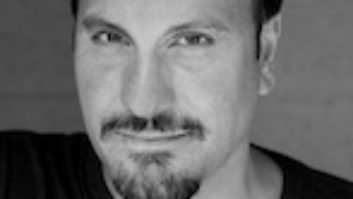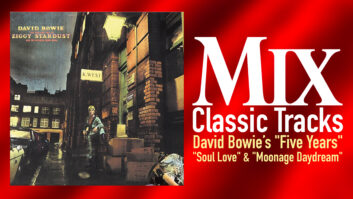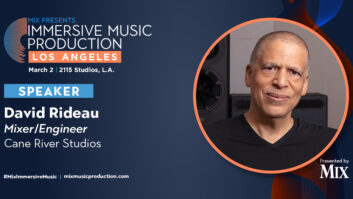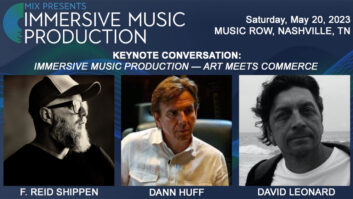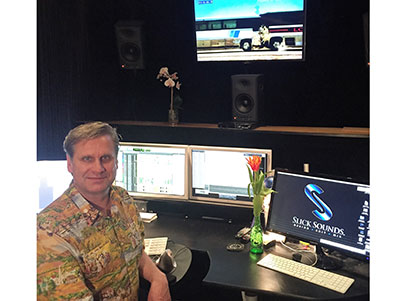
Sound designer David Van Slyke is a self-professed sound collector and hoarder, with a guesstimated 100,000-plus sounds in his private library of tools.
Some sounds he’s simply recorded at the moment he’s heard them, like the cool malfunctioning fan in the men’s room at the local Burger King (with his Olympus LS-10)— just thinking he might have use for the offbeat sound of it one day. Or the time he recorded someone’s washing machine that had “an amazing, pitching high frequency to it which I pull out every once in a while and use.”
On a trip to England, his cousins happened to have a beehive. He insisted upon getting fairly up close and personal with the bees with his DAT machine before animal control came by to eradicate them. He thought the sound of their swarming and flying over the hive was very cool and might come in handy one day.
It did. On the two-hour series finale of CSI, entitled “Immortality”—nominated earlier this year for an MPSE Golden Reel Award for Best Sound Editing in Television Long Form: Sound Effects & Foley—there was a bee scene, and his moment with the bees sure sounded better than any canned sound he could have found.
“I always travel with a recorder,” Van Slyke says. “It used to be a DAT recorder. Now it’s a digital handheld recorder. I even record things on the iPhone.”
But it’s not all happy accidents; Van Slyke also goes hunting for the perfect sound required for a frame like he did in the opener of the pilot for Gotham. As Bruce Wayne’s parents are murdered in front of him, his mother’s pearls break and hit the pavement in slow motion. The sound of the pearls cracking is brutal.
Van Slyke’s first experiment with breaking a strand of beads over his cement floor was not to his liking. He went searching through his house and came up with a porcelain pastry dish and dropped the beads into it. Voilà! Much more pronounced.
In the small studio in back of his house where he can obsess about his work any time, day or night, just blocks from his other studio at Sony Pictures, Van Slyke spoke about his journey from earning a degree at Berklee College of Music in traditional composition, to providing sound design and sound effects for 335 episodes and the finale of the smash-hit show CSI.
Once he got the recording bug, he transitioned from wanting to write music to wanting to produce and record, and spent six years in Boston doing post-production. He taught mixing at Berklee, heard about the Synclavier, and paid to go to White River Junction for a weekend to study it. Then he convinced Berklee to get a Synclavier. In 1990, he moved to Los Angeles.
“I was getting to do some good work in Boston, but big fish, small pond,” he says. “I was 30 at the time and thought I should take a chance.”
He paid some dues working all types of jobs in post-production, but it wasn’t long before he got his first “real” job on Baywatch, at Sony Pictures Studios.
“That was really at the dawn of digital,” he says. “Sony had just bought these [WaveFrame] AudioFrames, which is now a defunct DAW, but they were so cool. Back in that day, most anything you pitched had artifacts, but they somehow figured out how to do a four-octave range without artifacting, so we could make these really cool sounds.”
During his six years at Sony, Van Slyke worked on a range of projects, including sound effects editing on Francis Ford Coppola’s Bram Stoker’s Dracula, which won an Oscar for Best Sound Editing; Young Riders; and Dr. Quinn, Medicine Woman. On X-Files, Van Slyke was nominated for his first Emmy for an episode called “Duane Barry,” but his big recollection is for an episode called “The Host,” where he had to come up with sounds for the “flukeman.”
“There was this thing that came out of a guy’s mouth and it was just disgusting,” he recalls. “We went and got some raw chicken and abused the chicken. I was viscerally sick for a week because of the sounds we were making. The next week it went away and we were on to another episode.”
Today he works in front of his dual 23-inch monitors and 5.1 JBL surround system, designing and editing in Pro Tools 10 and 11. His library exceeds 3 terabytes, and he uses SoundMiner Version 4 to organize and search. The process for CSI was typical, he says, starting with receiving picture and a set of tracks over the Internet.

The core ‘CSI’ sound crew, from left: Frank Waldeck, line producer/director; Phil Conserva, post-production supervisor/director; Louis Shaw Milito, director of the two-hour special and longtime ‘CSI’ producer on the show; David F. Van Slyke, sound designer; and Anthony E. Zuiker, creator of the ‘CSI’ franchise and executive producer.
“They give you a set of production dialog, temp effects and music,” he explains. “The music is temped in. John Keane is a fabulous composer; he was on CSI as long as I was. Then you watch it once, twice, three times. I try to intuit from the picture what it wants. Sometimes I watch it in slow motion because we do a lot of things that are very fast.
“We have a certain approach to a scene—to really paint them and color them,” he continues. “It’s really like a composition. We have to use rhythm, timbre and feel. Even with a bird: It might be a happy bird, it may be a crow. Then exactly where it places has a beat to it. You have to look at the scene as a song and then you find places to crescendo things. Sometimes you crescendo at the end, sometimes in the middle.
“Post-production is like a quintet,” Van Slyke says. “The dialog is the lead instrument. The music is the second lead instrument. The sound design bridges the gap between sound effects and music and it has more of a musical quality than it does a sound effect quality. You hear it and think, ‘What is that? I don’t know.’ When I put it against picture, emotionally it pulls you in and tells you something about the story.”
One of the unique sound sets at CSI was the flash-ins and flashbacks, serving as transitions, which Van Slyke always had to create. Representing those, the picture might have glowed and the sound had to do the same thing. Or it might have sounded like wind or a gavel, something breathy or a little more like thunder.
Those moments often swirled into set rooms, which in turn were designed with characteristic sounds like technical beeps and blips, electronic and computer-based. “You could drop in and know you were in the morgue or in the interrogation room by the sound,” he says.
The job is arduous. A frame is one-24th of a second and Van Slyke admits it can take a day to create seven seconds of sound. But “the thing about television is you don’t always have a day,” he says. Typically he has five or six days for the 42 minutes of an episode.
His hard work and what he calls “the sound of cool sounding visual effects and gruesome violence, interspersed with a lot of talking about science and cop stuff” has been recognized, though. In his 15 years on CSI, he was nominated for eight Emmys, winning one for the 2003 episode called “Fight Night.” He also won two Golden Reel awards and two Hollywood Post Alliance awards.
No surprise that he experienced some postpartum feelings when the show ended.
“I went through a big grieving process,” he admits. “It was such a blessing and lasted so long. It ended kind of abruptly. We weren’t sure it was going to end or not. But we inspired so many crime shows.”
Among his many recent projects, Van Slyke has been working on a Sundance Film called Holy Hell about a cult. It requires a lot of archival footage, so he’s finding himself working with iZotope RX-5 and Waves WNS to remove hiss. He also designed the sound for the recently aired pilot for Lucifer.
His hope is to find another dramatic series that will turn into a long-term opportunity. He enjoys the consistency and relationships established while working on a series.
“I get to grow it and we come back to it and add to it,” Van Slyke concludes. “That’s what we did with CSI. Over the growth, we came up with new things. I like the work and the challenge of the time commitment. I love what I do.”

